SpringMvc请求流程源码解析
SpringMvc请求流程图#
请求流程粗讲解#
当用户发送请求之后,SpringMvc的DispatcherServlet就会收到请求,首先会进去父类的FrameworkServlet#service()
然后进入HttpServlet#service()
方法,作用就是判断是什么请求类型的,例如:GET、POST等。这个地方大致过一遍就行,主要是还是 org.springframework.web.servlet.DispatcherServlet#doService
这个方法回去调用org.springframework.web.servlet.DispatcherServlet#doDispatch
这才是请求开始的重点方法、对应上图中的请求--->这里便开始了请求的处理。
org.springframework.web.servlet.DispatcherServlet#doDispatch这个方法中的内容:
- 会进行映射,也就是常说的找到
Handler,在此步骤中拿到请求地址 例如:/user/info
对应方法:org.springframework.web.servlet.DispatcherServlet#getHandler - 选择合适的
HandlerAdapter映射适配器 - 执行前置拦截器
org.springframework.web.servlet.HandlerInterceptor#preHandle - 调用处理适配器执行
Handler - 执行后置处理器 ,对应方法:
org.springframework.web.servlet.HandlerInterceptor#postHandle - 解析返回值
- 执行最终的处理器,也就是视图返回之后的处理器
org.springframework.web.servlet.HandlerInterceptor#afterCompletion
方法细讲#
doDispatcher --> 核心#
org.springframework.web.servlet.DispatcherServlet#doDispatch
在这个方法中会进行上诉所有方法的调用,不作过多的解释方法添加了中文注释,下面看看这个方法的源码:
protected void doDispatch(HttpServletRequest request, HttpServletResponse response) throws Exception {
HttpServletRequest processedRequest = request;
HandlerExecutionChain mappedHandler = null;
boolean multipartRequestParsed = false;
WebAsyncManager asyncManager = WebAsyncUtils.getAsyncManager(request);
try {
ModelAndView mv = null;
Exception dispatchException = null;
try {
processedRequest = checkMultipart(request);
multipartRequestParsed = (processedRequest != request);
// Determine handler for the current request.
// 进行映射
mappedHandler = getHandler(processedRequest);
if (mappedHandler == null) {
noHandlerFound(processedRequest, response);
return;
}
// Determine handler adapter for the current request.
// HandlerAdapter 选择处理器适配器;找到最合适的 HandlerAdapter // 默认返回的是 RequestMappingHandlerAdapter
HandlerAdapter ha = getHandlerAdapter(mappedHandler.getHandler());
// Process last-modified header, if supported by the handler.
String method = request.getMethod();
boolean isGet = HttpMethod.GET.matches(method);
if (isGet || HttpMethod.HEAD.matches(method)) {
long lastModified = ha.getLastModified(request, mappedHandler.getHandler());
if (new ServletWebRequest(request, response).checkNotModified(lastModified) && isGet) {
return;
}
}
// 前置拦截器
if (!mappedHandler.applyPreHandle(processedRequest, response)) {
// 返回false后就不再进行处理了
return;
}
// Actually invoke the handler.
// 调用HandlerAdapter 的 handle 方法,对请求进行处理
mv = ha.handle(processedRequest, response, mappedHandler.getHandler());
if (asyncManager.isConcurrentHandlingStarted()) {
return;
}
// 如果么没有mv,会给一个默认是 mv
applyDefaultViewName(processedRequest, mv);
mappedHandler.applyPostHandle(processedRequest, response, mv);
}
catch (Exception ex) {
dispatchException = ex;
}
catch (Throwable err) {
// As of 4.3, we're processing Errors thrown from handler methods as well,
// making them available for @ExceptionHandler methods and other scenarios.
dispatchException = new NestedServletException("Handler dispatch failed", err);
}
processDispatchResult(processedRequest, response, mappedHandler, mv, dispatchException);
}
catch (Exception ex) {
triggerAfterCompletion(processedRequest, response, mappedHandler, ex);
}
catch (Throwable err) {
triggerAfterCompletion(processedRequest, response, mappedHandler,
new NestedServletException("Handler processing failed", err));
}
finally {
if (asyncManager.isConcurrentHandlingStarted()) {
// Instead of postHandle and afterCompletion
if (mappedHandler != null) {
mappedHandler.applyAfterConcurrentHandlingStarted(processedRequest, response);
}
}
else {
// Clean up any resources used by a multipart request.
if (multipartRequestParsed) {
cleanupMultipart(processedRequest);
}
}
}
找到Handler#getHandler#
org.springframework.web.servlet.DispatcherServlet#getHandler
该方法就是在 doDispatcher()中进行调用的,也就是对应流程中的 第一步:进行映射找到合适的Handler
看到这个方法的注释就是去找到最合适的Handler,需要方式就是去遍历所有的Handler找到一个合适的就直接返回,这个方法里面就会处理并且找到请求的地址
例如:http://127.0.0.1/request/mapping 就会把 /request/mapping给拿出来
方法调用链doDisptcher()->getHandler()->getHandlerInternal()->initLookupPath 会解析出请求路径
调用栈如下:
接下来进入 getHandler(processedRequest);方法,传入的参数其实就是 request: HttpServletRequest
getHandler(request)#
org.springframework.web.servlet.DispatcherServlet#getHandler
再次方法中会对请求进行处理,并找到合适的 Handler并返回,方法源码如下:
@Nullable
protected HandlerExecutionChain getHandler(HttpServletRequest request) throws Exception {
if (this.handlerMappings != null) {
/**
* 拿到所有的处理器映射器(handlerMappings)---容器初始化阶段拿到所有实现了HandlerMapping接口的Bean
* @see DispatcherServlet#initHandlerMappings
* 测试发现:不同的handlerMapping可以有相同的path,谁先解析就用谁
*/
for (HandlerMapping mapping : this.handlerMappings) {
HandlerExecutionChain handler = mapping.getHandler(request);
if (handler != null) {
return handler;
}
}
}
return null;
}
再次方法中会调用mapping.getHandler(request),this.handlerMappings
就是对请求进行处理的处理起,此处测试接口上写得就是 @RequestMapping对应的处理器就是 RequestMappingHandlerMapping
,测试发现:找到一个合适处理器就会直接进行返回,意思就是可能不会遍历完所有的处理器,就算后面又能够适配的,但是如果开始又可以处理的就直接返回了: 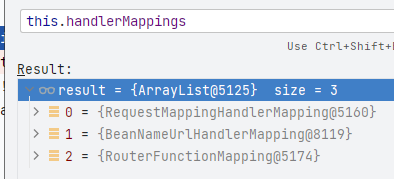
mapping.getHandler(request)#
这个方法没什么好讲的,感兴趣的可以自己去debug看看,这里讲重要的东西,多个HandlerMethod同时匹配怎么选择的问题,按照spring
惯用肯定是会返回最合适的一个,就如同推断构造方法进行分值计算一样,下次有空再跟大家分享,推断构造方法。
这里Debug发现mapping就是RequestMappingHandlerMapping
,并且直接匹配进行返回了,这里回去匹配路径,可能会匹配到多个路径,这里就回去选择对应的处理的HandlerMethod
,在org.springframework.web.servlet.handler.AbstractHandlerMethodMapping#lookupHandlerMethod
这个方法里面,会经过方法getHandlerInternal()
getHandlerInternal()#
protected HandlerMethod getHandlerInternal(HttpServletRequest request) throws Exception {
// 拿到请求地址,通过 UrlPathHelper 解析的
String lookupPath = initLookupPath(request);
this.mappingRegistry.acquireReadLock();
try {
// 通过lookupPath解析最终的handler----HandlerMethod对象
HandlerMethod handlerMethod = lookupHandlerMethod(lookupPath, request);
return (handlerMethod != null ? handlerMethod.createWithResolvedBean() : null);
}
finally {
this.mappingRegistry.releaseReadLock();
}
}
这个方法中就会去拿到对应的方法路径,并且调用lookupHandlerMethod(lookupPath, request);会返回唯一的HandlerMethod进行进一步封装
记住return的代码,这里如果找到的 handlerMethod有值就会去调用createWithResolvedBean(),getBean()
去获取对应的处理Bean,最后将处理方法以及对应的Handler封装到 HandlerMethod中。如何所示:
public HandlerMethod createWithResolvedBean() {
Object handler = this.bean;
if (this.bean instanceof String beanName) {
Assert.state(this.beanFactory != null, "Cannot resolve bean name without BeanFactory");
handler = this.beanFactory.getBean(beanName);
}
return new HandlerMethod(this, handler);
}
lookupHandlerMethod#
protected HandlerMethod lookupHandlerMethod(String lookupPath, HttpServletRequest request) throws Exception {
List<Match> matches = new ArrayList<>();
// 根据uri从mappingRegistry.pathLookup获取 RequestMappingInfo
// pathLookup<path,RequestMappingInfo>会在初始化阶段解析好
List<T> directPathMatches = this.mappingRegistry.getMappingsByDirectPath(lookupPath);
if (directPathMatches != null) {
// 如果根据path能直接匹配的RequestMappingInfo 则用该mapping进行匹配其他条件(method、header等)
addMatchingMappings(directPathMatches, matches, request);
}
if (matches.isEmpty()) {
// 如果无path匹配,用所有的 RequestMappingInfo 通过AntPathMatcher匹配
addMatchingMappings(this.mappingRegistry.getRegistrations().keySet(), matches, request);
}
if (!matches.isEmpty()) {
// 选择第一个为最匹配的
Match bestMatch = matches.get(0);
/*
如果匹配到过个
@RequestMapping(value="/mappin?")
@RequestMapping(value="/mappin*")
@RequestMapping(value="/{xxxx}")
@RequestMapping(value="/**")
*/
if (matches.size() > 1) {
// 创建 MatchComparator 匹配器
Comparator<Match> comparator = new MatchComparator(getMappingComparator(request));
/** 根据精准度排序 大概是这样的: ? > * > {} > ** 具体可以去看:
* @see org.springframework.util.AntPathMatcher.AntPatternComparator#compare(java.lang.String, java.lang.String)*/
matches.sort(comparator);
// 排完序之后拿到优先等级最高的,也就是第一个
bestMatch = matches.get(0);
if (logger.isTraceEnabled()) {
logger.trace(matches.size() + " matching mappings: " + matches);
}
// 是否配置CORS, 并且是否匹配
if (CorsUtils.isPreFlightRequest(request)) {
for (Match match : matches) {
if (match.hasCorsConfig()) {
return PREFLIGHT_AMBIGUOUS_MATCH;
}
}
}
else {
// 获得第二匹配的。如果和第一个一样,则抛出异常
Match secondBestMatch = matches.get(1);
if (comparator.compare(bestMatch, secondBestMatch) == 0) {
Method m1 = bestMatch.getHandlerMethod().getMethod();
Method m2 = secondBestMatch.getHandlerMethod().getMethod();
String uri = request.getRequestURI();
throw new IllegalStateException(
"Ambiguous handler methods mapped for '" + uri + "': {" + m1 + ", " + m2 + "}");
}
}
}
// 将最匹配的设置到 request 中
request.setAttribute(BEST_MATCHING_HANDLER_ATTRIBUTE, bestMatch.getHandlerMethod());
handleMatch(bestMatch.mapping, lookupPath, request);
// 返回最匹配的
return bestMatch.getHandlerMethod();
}
else {
// return null
return handleNoMatch(this.mappingRegistry.getRegistrations().keySet(), lookupPath, request);
}
}
在源码注释中已经表示了匹配多个的情况是怎么区分的,匹配多个的情况并且想要整长执行必须是使用通配符的方式(? > * > {} > **)
,如果出现两个相同的路径,mvc则会抛出异常,讲到这里差不多第一个步骤就结束了,找到了合适的 handlerMethod
并且将HandlerMethod存储在了request中;
- 存储:
request.setAttribute(BEST_MATCHING_HANDLER_ATTRIBUTE, bestMatch.getHandlerMethod()); - 存储的key:
String BEST_MATCHING_HANDLER_ATTRIBUTE = HandlerMapping.class.getName() + ".bestMatchingHandler"; - key=
org.springframework.web.servlet.HandlerMapping.bestMatchingHandler
找到之后就会返回对应的Handler,就是能够处理这个请求的那个 Bean,也是就是我们程序员些的 Controller
这里寻找HandlerMethod会直接使用解析出来的路径去pathLookup中去拿。pathLookup
是一个map,在springmvc启动的时候就会解析我们定义的@RequestMapping中的值,并作为key存储在pathLookup
中;下一次讲springmvc启动流程的时候在解释
public List<T> getMappingsByDirectPath(String urlPath){
return this.pathLookup.get(urlPath);
}
找到HandlerAdapter#getHandlerAdapter#
org.springframework.web.servlet.DispatcherServlet#getHandlerAdapter
这个点对应请求流程图中的第二步,找到合适的HandlerAdapter,我们看一下具体是怎么找的
getHandlerAdapter#
这里传进来的就是 在第一步中找到的:HandlerMethod,这里和寻找Handler
一个套路的,找到合适的直接返回,不会再去走下面的 HandlerAdapter
protected HandlerAdapter getHandlerAdapter(Object handler) throws ServletException {
if (this.handlerAdapters != null) {
for (HandlerAdapter adapter : this.handlerAdapters) {
if (adapter.supports(handler)) {
return adapter;
}
}
}
throw new ServletException("No adapter for handler [" + handler +
"]: The DispatcherServlet configuration needs to include a HandlerAdapter that supports this handler");
}
adapter.supports(handler)#
看一下个方法,其实也没什么,只是判断当前的HandlerAdapter是否支持处理 handlerMethod
public final boolean supports(Object handler) {
return (handler instanceof HandlerMethod && supportsInternal((HandlerMethod) handler));
}
supportsInternal((HandlerMethod) handler) 这个方法在 RequestMappingHandlerAdapter类中默认返回 true
执行前置拦截器#
org.springframework.web.servlet.HandlerExecutionChain#applyPreHandle
boolean applyPreHandle(HttpServletRequest request, HttpServletResponse response) throws Exception {
for (int i = 0; i < this.interceptorList.size(); i++) {
HandlerInterceptor interceptor = this.interceptorList.get(i);
if (!interceptor.preHandle(request, response, this.handler)) {
triggerAfterCompletion(request, response, null);
return false;
}
// 存储执行到了哪些拦截器,如果出现了前置拦截器返回false的情况,那么最终拦截器也只执行到i下标的那一个
this.interceptorIndex = i;
}
return true;
}
这个没啥好讲的,大家看一下这个源码,意思就是遍历扫描的时候拿到的所有的拦截器(实现了 HandlerIntercepter接口的)
,拿出来全部调用其preHandle 方法
注意:如果前置拦截器返回了false
那么意思就代表此请求被拦截掉了,要去执行最终拦截器,这个点放到流程最后讲。也就是调用拦截器的afterCompletion方法
执行Handler--会去执行真正的方法#
org.springframework.web.servlet.HandlerAdapter#handle
handle()->handleInternal,最红会执行到下面的handleInternal方法
org.springframework.web.servlet.mvc.method.annotation.RequestMappingHandlerAdapter#handleInternal
方法执行栈:
方法执行链:
- handle: 执行
controller方法的的进入点 - getMethodArgumentValue:解析方法入参,解析完就回去真正的执行
HandlerMethod
protected ModelAndView handleInternal(HttpServletRequest request,
HttpServletResponse response,HandlerMethod handlerMethod)throws Exception{
ModelAndView mav;
// 检查当前请求的method是否为支持的method(默认为null,可以通过继承AbstractController设置supportedMethod)
// 检查当前请求是够必须 session(默认为false,可以通过继承AbstractController 设置requireSession)
checkRequest(request);
/**
* 判断当前是否需要支持在同一个session中只能线性地处理请求
* 因为锁是通过 synchronized 是 JVM 进程级,所以在分布式环境下,
* 无法达到同步相同 Session 的功能。默认情况下,synchronizeOnSession 为 false
*/
// Execute invokeHandlerMethod in synchronized block if required.
if(this.synchronizeOnSession){
// 获取当前请求的 Session 对象
HttpSession session=request.getSession(false);
if(session!=null){
// 为当前session 生成唯一的一个可以用于锁定的key
Object mutex=WebUtils.getSessionMutex(session);
synchronized (mutex){
// 对HandlerMethod进行参数等的适配处理,并调用目标handler
mav=invokeHandlerMethod(request,response,handlerMethod);
}
}else{
// 如果当前不存在session,则直接对HandlerMethod进行适配
// No HttpSession available -> no mutex necessary
mav=invokeHandlerMethod(request,response,handlerMethod);
}
}
else{
// No synchronization on session demanded at all...
// *如果当前不需要对session进行同步处理,则直接对HandlerMethod进行适配
mav=invokeHandlerMethod(request,response,handlerMethod);
}
//判断当前请求头中是否包含Cache-Control请求头,如果不包含,则对当前response进行处理
if(!response.containsHeader(HEADER_CACHE_CONTROL)){
if(getSessionAttributesHandler(handlerMethod).hasSessionAttributes()){
applyCacheSeconds(response,this.cacheSecondsForSessionAttributeHandlers);
}
else{
prepareResponse(response);
}
}
return mav;
}
在这个方法中我们主要看invokeHandlerMethod()方法,从方法名称就能看出是去执行开始选出来的handlerMethod
方法,也就是我们自己写的controller的方法,下面看一下该方法的源码,方法有中文注释,推荐自己debug看一遍
invokHandlerMethod#
@Nullable
protected ModelAndView invokeHandlerMethod(HttpServletRequest request,
HttpServletResponse response,HandlerMethod handlerMethod)throws Exception{
// 将request response 包装成 ServletWebRequest
ServletWebRequest webRequest=new ServletWebRequest(request,response);
try{
// 获取容器中全局配置的InitBinder和当前HandlerMethod所对应的Controller中
// 配置的InitBinder,用于进行参数的绑定
WebDataBinderFactory binderFactory=getDataBinderFactory(handlerMethod);
// 获取容器中全局配置的ModelAttribute和当前HandlerMethod所对应的Controller 中配置的ModelAttribute,
// 这些配置的方法将会在目标方法调用之前进行调用
ModelFactory modelFactory=getModelFactory(handlerMethod,binderFactory);
// 封装HandlerMethod,会在调用前进行参数解析,调用后对返回值进行处理
ServletInvocableHandlerMethod invocableMethod=createInvocableHandlerMethod(handlerMethod);
if(this.argumentResolvers!=null){
// 让invocableMethod 有解析参数的能力
invocableMethod.setHandlerMethodArgumentResolvers(this.argumentResolvers);
}
if(this.returnValueHandlers!=null){
// 让 invocableMethod 有处理返回值的能力
invocableMethod.setHandlerMethodReturnValueHandlers(this.returnValueHandlers);
}
// 让invocableMethod拥有InitBinder解析能力
invocableMethod.setDataBinderFactory(binderFactory);
// 设置ParameterNameDiscoverer,该对象将按照一定的规则获取当前参数的名称
invocableMethod.setParameterNameDiscoverer(this.parameterNameDiscoverer);
// ModelAndView处理容器
ModelAndViewContainer mavContainer=new ModelAndViewContainer();
// 将request的Attribute复制一份到ModelMap
mavContainer.addAllAttributes(RequestContextUtils.getInputFlashMap(request));
// *调用我们标注了@ModelAttribute的方法,主要是为我们的目标方法预加载
modelFactory.initModel(webRequest,mavContainer,invocableMethod);
// 重定向的时候,忽略model中的数据 默认false
mavContainer.setIgnoreDefaultModelOnRedirect(this.ignoreDefaultModelOnRedirect);
// 获取当前的AsyncWebRequest,这里AsyncWebRequest的主要作用是用于判断目标
// handler的返回值是否为WebAsyncTask或DeferredResult,如果是这两种中的一种,
// 则说明当前请求的处理应该是异步的。所谓的异步,指的是当前请求会将Controller中
// 封装的业务逻辑放到一个线程池中进行调用,待该调用有返回结果之后再返回到response中。
// 这种处理的优点在于用于请求分发的线程能够解放出来,从而处理更多的请求,提高吞吐。
// 只有待目标任务完成之后才会回来将该异步任务的结果返回。
AsyncWebRequest asyncWebRequest=WebAsyncUtils.createAsyncWebRequest(request,response);
asyncWebRequest.setTimeout(this.asyncRequestTimeout);
// 封装异步任务的线程池、request、interceptors到WebAsyncManager中
WebAsyncManager asyncManager=WebAsyncUtils.getAsyncManager(request);
asyncManager.setTaskExecutor(this.taskExecutor);
asyncManager.setAsyncWebRequest(asyncWebRequest);
asyncManager.registerCallableInterceptors(this.callableInterceptors);
asyncManager.registerDeferredResultInterceptors(this.deferredResultInterceptors);
// 这里就是用于判断当前请求是否有异步任务结果的,如果存在,则对异步任务结果进行封装
if(asyncManager.hasConcurrentResult()){
Object result=asyncManager.getConcurrentResult();
mavContainer=(ModelAndViewContainer)asyncManager.getConcurrentResultContext()[0];
asyncManager.clearConcurrentResult();
LogFormatUtils.traceDebug(logger,traceOn->{
String formatted=LogFormatUtils.formatValue(result,!traceOn);
return"Resume with async result ["+formatted+"]";
});
invocableMethod=invocableMethod.wrapConcurrentResult(result);
}
// *对请求参数进行处理,调用目标HandlerMethod,并且将返回值封装为一个ModelAndView对象 很重要
invocableMethod.invokeAndHandle(webRequest,mavContainer);
if(asyncManager.isConcurrentHandlingStarted()){
return null;
}
// 对封装的ModelAndView进行处理,主要是判断当前请求是否进行了重定向,如果进行了重定向,
// 还会判断是否需要将FlashAttributes封装到新的请求中
return getModelAndView(mavContainer,modelFactory,webRequest);
}
finally{
webRequest.requestCompleted();
}
}
上述方法重要点就在 invocableMethod.invokeAndHandle(webRequest, mavContainer);,这里就回去执行方法并且处理返回的对象
invokeAndHandle#
public void invokeAndHandle(ServletWebRequest webRequest,ModelAndViewContainer mavContainer,
Object...providedArgs)throws Exception{
/* 真正的调用目标方法。很重要、很重要*/
Object returnValue=invokeForRequest(webRequest,mavContainer,providedArgs);
// 设置相关的返回状态
setResponseStatus(webRequest);
// 如果请求完成,则设置requestHandler 属性
if(returnValue==null){
if(isRequestNotModified(webRequest)||getResponseStatus()!=null||mavContainer.isRequestHandled()){
disableContentCachingIfNecessary(webRequest);
mavContainer.setRequestHandled(true);
return;
}
}
// 如果请求失败但是有错误原因,也会设置 requestHandler 属性
else if(StringUtils.hasText(getResponseStatusReason())){
mavContainer.setRequestHandled(true);
return;
}
mavContainer.setRequestHandled(false);
Assert.state(this.returnValueHandlers!=null,"No return value handlers");
try{
// 遍历当前容器中所有ReturnValueHandler,判断哪种handler支持当前返回值的处理,
// 如果支持,则使用该handler处理该返回值
this.returnValueHandlers.handleReturnValue(
returnValue,getReturnValueType(returnValue),mavContainer,webRequest);
}
catch(Exception ex){
if(logger.isTraceEnabled()){
logger.trace(formatErrorForReturnValue(returnValue),ex);
}
throw ex;
}
}
在invokeForRequest方法中有一个很重要的方法 getMethodArgumentValues
getMethodArgumentValues#
protected Object[]getMethodArgumentValues(NativeWebRequest request,@Nullable ModelAndViewContainer mavContainer,
Object...providedArgs)throws Exception{
// 获取目标方法参数的描述数组对象
MethodParameter[]parameters=getMethodParameters();
if(ObjectUtils.isEmpty(parameters)){
return EMPTY_ARGS;
}
//用来初始化我们对应参数名称的参数值得数组
Object[]args=new Object[parameters.length];
// 循环拿到参数名数组
for(int i=0;i<parameters.length;i++){
MethodParameter parameter=parameters[i];
//为我们得MethodParameter设置参数名称探测器对象
parameter.initParameterNameDiscovery(this.parameterNameDiscoverer);
args[i]=findProvidedArgument(parameter,providedArgs);
if(args[i]!=null){
continue;
}
// * 获取所有的参数解析器,然后筛选出合适的解析器
if(!this.resolvers.supportsParameter(parameter)){
throw new IllegalStateException(formatArgumentError(parameter,"No suitable resolver"));
}
try{
// 通过上面筛选的 参数解析器来解析我们的参数
args[i]=this.resolvers.resolveArgument(parameter,mavContainer,request,this.dataBinderFactory);
}catch(Exception ex){
// Leave stack trace for later, exception may actually be resolved and handled...
if(logger.isDebugEnabled()){
String exMsg=ex.getMessage();
if(exMsg!=null&&!exMsg.contains(parameter.getExecutable().toGenericString())){
logger.debug(formatArgumentError(parameter,exMsg));
}
}
throw ex;
}
}
return args;
}
解析完方法后就会去调用doInvokle执行Controller的方法。
注意:在invokAndHandle中有处理返回值的方法调用,也就是下面这个
// 遍历当前容器中所有ReturnValueHandler,判断哪种handler支持当前返回值的处理,
// 如果支持,则使用该handler处理该返回值
this.returnValueHandlers.handleReturnValue(
returnValue, getReturnValueType(returnValue), mavContainer, webRequest);
handleReturnValue#
public void handleReturnValue(@Nullable Object returnValue,MethodParameter returnType,
ModelAndViewContainer mavContainer,NativeWebRequest webRequest)throws Exception{
// 根据返回的类型选择返回值解析器
HandlerMethodReturnValueHandler handler=selectHandler(returnValue,returnType);
if(handler==null){
throw new IllegalArgumentException("Unknown return value type: "+returnType.getParameterType().getName());
}
handler.handleReturnValue(returnValue,returnType,mavContainer,webRequest);
}
这个selectHandler选择返回值解析器和之前的是一个套路,找到了直接返回解析器,然后调用解析器的HandleReturnValue
进行处理,这里是返回的ModelAndVierw也就是jsp,对应的处理器就是ModelAndViewMethodValueHandler,如果是Json
那么对应的是ReqeustResponseBodyMethodProcessor
这里ModelAndView的返回类型的处理,方法在下面一个类中,自己也能够看懂,讲到这里返回值返回ModelAndView就结束了。下面就是查找视图以及渲染视图
org.springframework.web.servlet.mvc.method.annotation.ModelAndViewMethodReturnValueHandler#handleReturnValue
查找视图#
org.springframework.web.servlet.DispatcherServlet#processDispatchResult
在此方法中进行处理,根据方法名processDispatchResult得知,处理转发结果
private void processDispatchResult(HttpServletRequest request,HttpServletResponse response,
@Nullable HandlerExecutionChain mappedHandler,@Nullable ModelAndView mv,
@Nullable Exception exception)throws Exception{
boolean errorView=false;
// 异常视图
if(exception!=null){
if(exception instanceof ModelAndViewDefiningException){
logger.debug("ModelAndViewDefiningException encountered",exception);
mv=((ModelAndViewDefiningException)exception).getModelAndView();
}
else{
Object handler=(mappedHandler!=null?mappedHandler.getHandler():null);
mv=processHandlerException(request,response,handler,exception);
errorView=(mv!=null);
}
}
// Did the handler return a view to render?
if(mv!=null&&!mv.wasCleared()){
// 解析、渲染视图
render(mv,request,response);
if(errorView){
WebUtils.clearErrorRequestAttributes(request);
}
}
else{
if(logger.isTraceEnabled()){
logger.trace("No view rendering, null ModelAndView returned.");
}
}
if(WebAsyncUtils.getAsyncManager(request).isConcurrentHandlingStarted()){
// Concurrent handling started during a forward
return;
}
if(mappedHandler!=null){
// Exception (if any) is already handled.. 拦截器:AfterCompletion
mappedHandler.triggerAfterCompletion(request,response,null);
}
}
此方法中的重要点render(),mappedHandler.triggerAfterCompletion(request, response, null);,可以看到如果出现了异常,会进入异常视图
rendee:视图进行渲染triggerAfterCompletion: 执行最终拦截器afterCompletion
方法的调用,这里是请求成功没有被拦截,所以直接调用所有的拦截器的afterCompletion方法
render视图查找#
protected void render(ModelAndView mv,HttpServletRequest request,HttpServletResponse response)throws Exception{
// Determine locale for request and apply it to the response.
Locale locale=
(this.localeResolver!=null?this.localeResolver.resolveLocale(request):request.getLocale());
response.setLocale(locale);
View view;
String viewName=mv.getViewName();
if(viewName!=null){
// 解析视图名称
// We need to resolve the view name.
view=resolveViewName(viewName,mv.getModelInternal(),locale,request);
if(view==null){
throw new ServletException("Could not resolve view with name '"+mv.getViewName()+
"' in servlet with name '"+getServletName()+"'");
}
}
else{
// No need to lookup: the ModelAndView object contains the actual View object.
view=mv.getView();
if(view==null){
throw new ServletException("ModelAndView ["+mv+"] neither contains a view name nor a "+
"View object in servlet with name '"+getServletName()+"'");
}
}
...省略 log 代码...
try{
if(mv.getStatus()!=null){
request.setAttribute(View.RESPONSE_STATUS_ATTRIBUTE,mv.getStatus());
response.setStatus(mv.getStatus().value());
}
view.render(mv.getModelInternal(),request,response);
}
catch(Exception ex){
...省略 log 代码...
throw ex;
}
}
可以看到上面的源码中有一个解析视图名称的代码,其实就是前缀+viewName+后缀,但是:
这里获取选择对应的视图解析器,和上面的选择套路一样,此处还解析了反正值得前缀以及看是redirect还是forward
,根据这个前缀的不同创建不同的视图解析器
此处使用的是InternalResourceViewResolver,
视图渲染#
view.render(mv.getModelInternal(), request, response);
最终会走到
org.springframework.web.servlet.view.InternalResourceView#renderMergedOutputModel
protected void renderMergedOutputModel(
Map<String, Object> model,HttpServletRequest request,HttpServletResponse response)throws Exception{
// Expose the model object as request attributes.
// 将model设置到request 的Attribute 中
exposeModelAsRequestAttributes(model,request);
// Expose helpers as request attributes, if any.
// 设置国际化资源
exposeHelpers(request);
// Determine the path for the request dispatcher.
// 防止死循环,就是请求路径和转发路径一致
String dispatcherPath=prepareForRendering(request,response);
// Obtain a RequestDispatcher for the target resource (typically a JSP).
// 通过 request 拿到 RequestDispatcher;request.getRequestDispacther("/test.jsp")
RequestDispatcher rd=getRequestDispatcher(request,dispatcherPath);
if(rd==null){
throw new ServletException("Could not get RequestDispatcher for ["+getUrl()+
"]: Check that the corresponding file exists within your web application archive!");
}
// If already included or response already committed, perform include, else forward.
if(useInclude(request,response)){
response.setContentType(getContentType());
if(logger.isDebugEnabled()){
logger.debug("Including ["+getUrl()+"]");
}
rd.include(request,response);
}
else{
// Note: The forwarded resource is supposed to determine the content type itself.
if(logger.isDebugEnabled()){
logger.debug("Forwarding to ["+getUrl()+"]");
}
// RequestDispatcher.forward直接转发
rd.forward(request,response);
}
}
最后是直接走的Servlet
的转发,至此响应客户端完成,还得注意方法中进行了一次判断,防止请求死循环的。就是判断请求路径与转发路径是否一直,如果一致的情况下就会造成请求死循环,例如:请求路径:/user/info
、转发路径:/user/info,这种情况下就会造成死循环。
最终处理器#
org.springframework.web.servlet.HandlerExecutionChain#triggerAfterCompletion
最后进入doDispatcher中的 tiggerAfterCompletion
方法,这个请求是成功的所以所有的拦截器都需要执行最终拦截,不同于前置拦截器preHandle拦截的时候
这里会去直接循环调用拦截器的afterCompletion方法
void triggerAfterCompletion(HttpServletRequest request,HttpServletResponse response,@Nullable Exception ex){
for(int i=this.interceptorIndex;i>=0;i--){
HandlerInterceptor interceptor=this.interceptorList.get(i);
try{
interceptor.afterCompletion(request,response,this.handler,ex);
}
catch(Throwable ex2){
logger.error("HandlerInterceptor.afterCompletion threw exception",ex2);
}
}
}
至此请求结束。
如文中又错误请指出或者联系我:tianxiang.deng@foxmail.com
作者:BaldHead
出处:https://www.cnblogs.com/strict/p/16640734.html
版权:本作品采用「署名-非商业性使用-相同方式共享 4.0 国际」许可协议进行许可。
推荐:文中如有错误欢迎指出,评论或者[ 邮箱 ]告诉我,感谢阅读!。
本文来自博客园,作者:BaldHead,转载请注明原文链接:https://www.cnblogs.com/strict/p/16640734.html

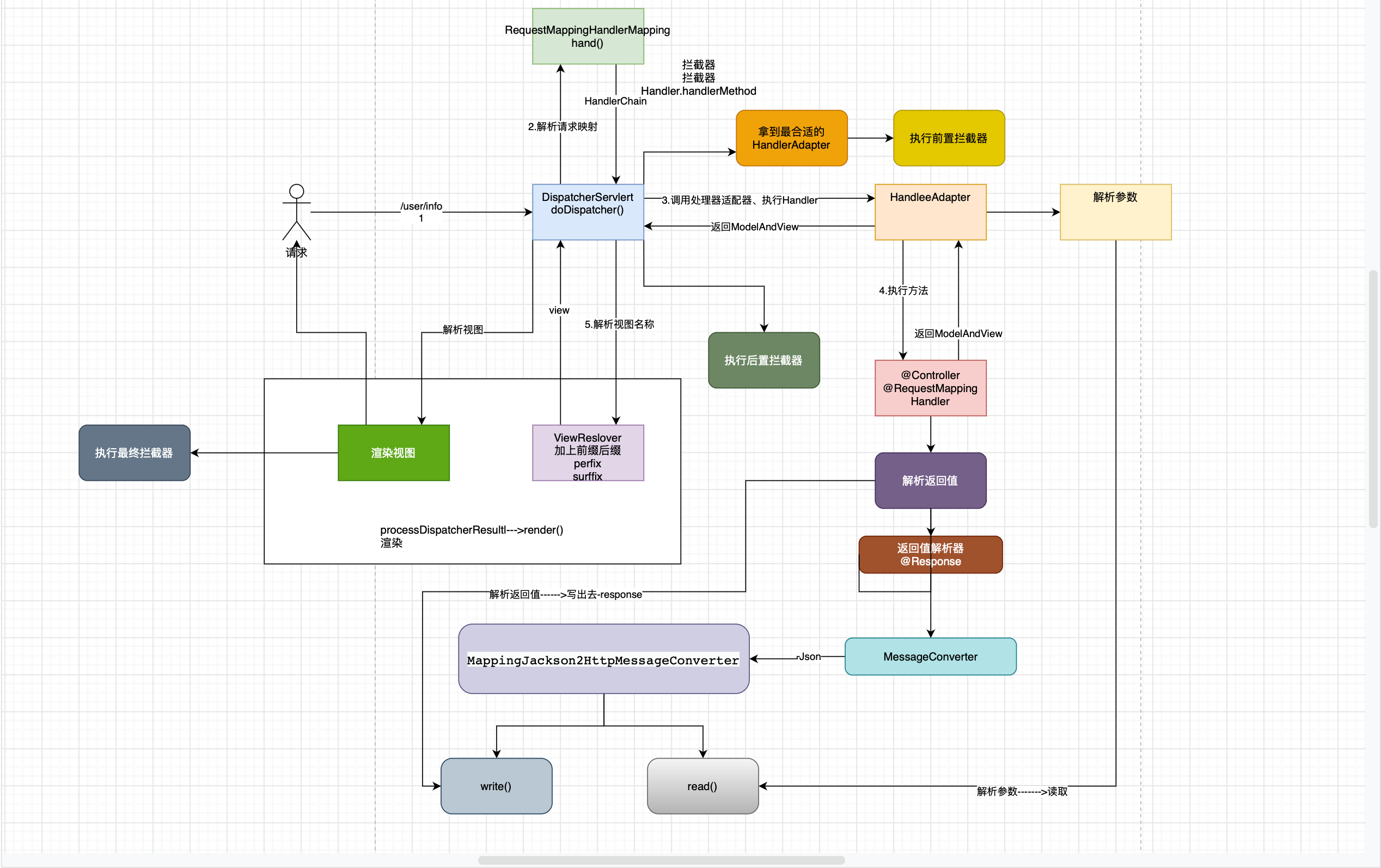


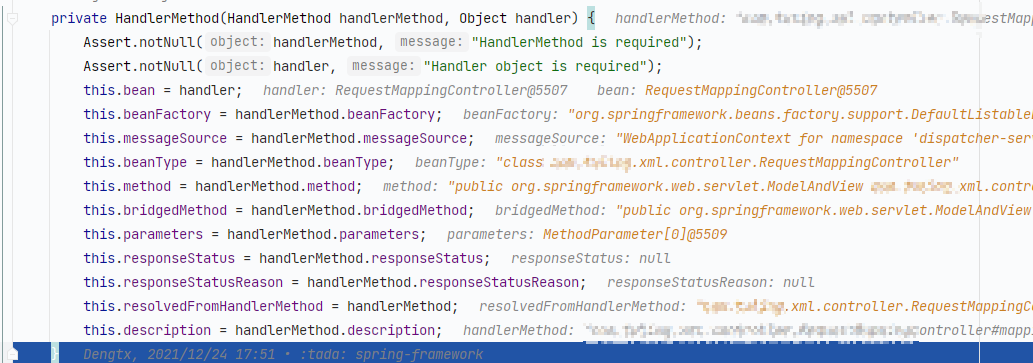
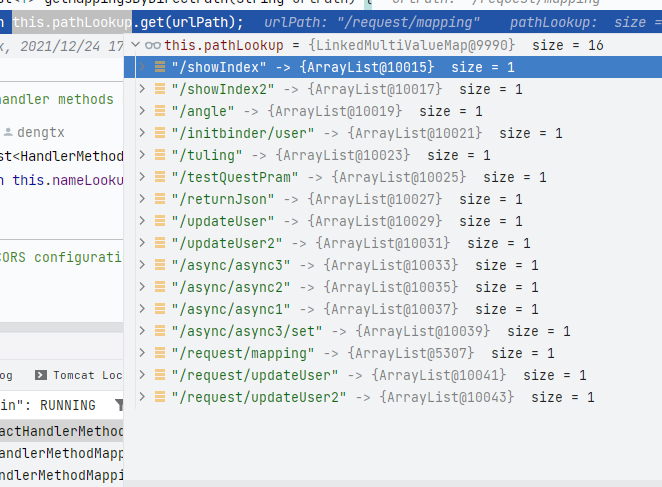



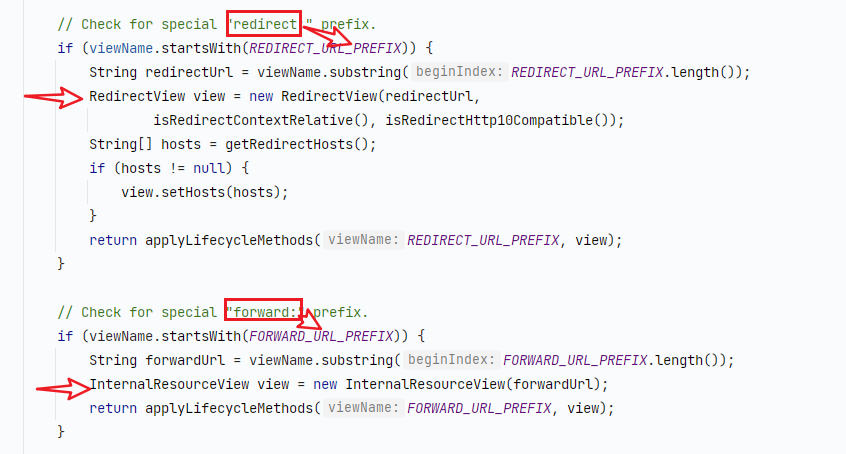





【推荐】国内首个AI IDE,深度理解中文开发场景,立即下载体验Trae
【推荐】编程新体验,更懂你的AI,立即体验豆包MarsCode编程助手
【推荐】抖音旗下AI助手豆包,你的智能百科全书,全免费不限次数
【推荐】轻量又高性能的 SSH 工具 IShell:AI 加持,快人一步
· 无需6万激活码!GitHub神秘组织3小时极速复刻Manus,手把手教你使用OpenManus搭建本
· C#/.NET/.NET Core优秀项目和框架2025年2月简报
· Manus爆火,是硬核还是营销?
· 终于写完轮子一部分:tcp代理 了,记录一下
· 【杭电多校比赛记录】2025“钉耙编程”中国大学生算法设计春季联赛(1)